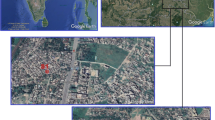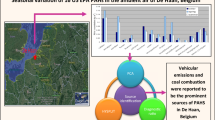Abstract
This study reports source apportionment of polycyclic aromatic hydrocarbons (PAHs) in particulate depositions on vegetation foliages near highway in the urban environment of Lucknow city (India) using the principal components analysis/absolute principal components scores (PCA/APCS) receptor modeling approach. The multivariate method enables identification of major PAHs sources along with their quantitative contributions with respect to individual PAH. The PCA identified three major sources of PAHs viz. combustion, vehicular emissions, and diesel based activities. The PCA/APCS receptor modeling approach revealed that the combustion sources (natural gas, wood, coal/coke, biomass) contributed 19–97% of various PAHs, vehicular emissions 0–70%, diesel based sources 0–81% and other miscellaneous sources 0–20% of different PAHs. The contributions of major pyrolytic and petrogenic sources to the total PAHs were 56 and 42%, respectively. Further, the combustion related sources contribute major fraction of the carcinogenic PAHs in the study area. High correlation coefficient (R 2 > 0.75 for most PAHs) between the measured and predicted concentrations of PAHs suggests for the applicability of the PCA/APCS receptor modeling approach for estimation of source contribution to the PAHs in particulates.
Similar content being viewed by others
References
ATSDR (1995). Toxicological profile for polycyclic aromatic hydrocarbons (PAHs). Agency for Toxic Substances and Disease Registry (ATSDR). Atlanta, GA: US Department of Health and Human Services, Public Health Service.
Bakker, M., Koerselman, J., Tolls, J., & Kolloffel, C. (2001). Localization of deposited polycyclic aromatic hydrocarbons in leaves of Plantago. Environmental Toxicology and Chemistry, 20, 1112–1116.
Bakker, M., Vorenhout, M., & Kolloffel, C. (1999). Dry deposition of atmospheric polycyclic aromatic hydrocarbons in three Plantago species. Environmental Toxicology and Chemistry, 18, 2289–2294.
Bhargava, A., Khanna, R. N., Bhargava, S. K., & Kumar, S. (2004). Exposure risk to carcinogenic PAHs in indoor-air during biomass combustion whilst cooking in rural India. Atmospheric Environment, 38, 4761–4767.
Bruno, P., Caselli, M., de Gennaro, G., & Traini, A. (2001). Source apportionment of gaseous atmospheric pollutants by means of an absolute principal component scores (APCS) receptor model. Fresenius Journal of Analytical Chemistry, 371, 1119–1123.
Buhamra, S. S., Bouhamra, W. S., & Elkilani, A. S. (1998). Assessment of air quality in ninety-nine residences of Kuwait. Environmental Technology, 19, 357–367.
Chamberlin, A. C., & Little, P. (1981). Plants and their atmospheric environment. In J. Grace, et al. (Eds.), (pp. 147–173). Oxford: Blackwell Scientific.
Derwent, R. G., Middleton, D. R., Field, R. A., Goldstone, M. E., Lester, J. N., & Perry, R. (1995). Analysis and interpretation of air quality data from an urban roadside location in Central London over the period from July 1991 to July 1992. Atmospheric Environment, 29, 923–946.
Freeman, D. J., & Cattel, C. R. (1990). Wood burning as a source of atmospheric polycyclic aromatic hydrocarbons. Environmental Science and Technology, 24, 1581–1585.
Fung, Y. S., & Wong, L. W. Y. (1995). Apportionment of air pollution sources by receptor models in Hong Kong. Atmospheric Environment, 29, 2041–2048.
Guo, H., Wang, T., & Louie, P. K. K. (2004). Source apportionment of ambient non-methane hydrocarbons in Hong Kong: Application of a principal component analysis/absolute principal component scores (PCA/APCS) receptor model. Environmental Pollution, 129, 489–498.
Harrison, R. M., Smith, D. J. T., & Luhana, L. (1996). Source apportionment of atmospheric polycyclic aromatic hydrocarbons collected from an urban location in Birmingham, U.K. Environmental Science and Technology, 30, 825–832.
Henry, R. C. (1997). History and fundamentals of multivariate air quality receptor models. Chemometrics and Intelligent Laboratory Systems, 37, 37–42.
Howsam, M., Jones, K. C., & Ineson, P. (2000a). PAHs associated with the leaves of three deciduous tree species. I. Concentrations and profiles. Environmental Pollution, 108, 413–424.
Howsam, M., Jones, K. C., & Ineson, P. (2000b). PAHs in the soils of a mature, mixed-deciduous (Quercus–Fraxinus) woodland and the surrounding pasture. Water, Air and Soil Pollution, 121, 379–398.
IARC (1987). Overall evaluation of carcinogenicity: An updating of IARC monographs. IARC monographs on the evaluation of carcinogenic risk to humans. (Vols. 1–42, Suppl. 7) Lyon, France: International Agency for Research on Cancer.
Jackson, D. A. (1993). Stopping rules in principal components analysis: A comparison of heuristical and statistical approaches. Ecology, 74, 2204–2214.
Jones, D. M., Rowland, S. J., Douglas, A. G., & Howells, S. (1986). An examination of the Fate of Nigerian crude oil in surface sediments of the Humber estuary by gas chromatography and gas chromatography–mass spectrometry. International Journal of Environmental and Analytical Chemistry, 24, 227–247.
Jones, K. C., Sanders, G., Wild, S. R., Burnett, V., & Johnston, A. E. (1992). Evidence for a decline of PCBs and PAHs in rural vegetation and air in the United Kingdom. Nature, 365, 137–140.
Kaupp, H. (1996). Atmospharische eintragswege und verhalten von polychlorierten di-benzo-p-dioxinen und-furanen sowie polyzyklischen Aromaten in einem Maisbestand, Ph. D. Thesis, University of Bayreuth, Bayreuth.
Khalili, N. R., Scheff, P. A., & Holsen, T. M. (1995). PAH source fingerprints for coke ovens, diesel and gasoline engines, highway tunnels, and wood combustion emissions. Atmospheric Environment, 29, 533–542.
King, J. R., & Jackson, D. A. (1999). Variable selection in large environmental data sets using principal components analysis. Environmetrics, 10, 67–77.
Larsen, R. K., & Baker, J. E. (2003). Source apportionment of polycyclic aromatic hydrocarbons in the urban atmosphere: A comparison of three methods. Environmental Science and Technology, 37, 1873–1881.
Larsson, B., & Sahlberg, G. (1982). Polynuclear aromatic hydrocarbons: Physical and biological chemistry. In M. Cooke, et al. (Eds.), (pp. 417–426). New York: Springer.
Lawley, D. N., & Maxwell, A. E. (1971). Factor analysis as a statistical method (2nd ed.). London: Butterworths.
Li, C. K., & Kamens, R. M. P. (1993). The use of polycyclic aromatic hydrocarbons as source signatures in receptor modeling. Atmospheric Environment, 27A, 523–532.
Mastral, A. M., Callen, M., & Murillo, R. (1996). Assessment of PAH emissions as a function of coal combustion variables. Fuel, 75, 1533–1536.
McVeety, B. D., & Hites, R. A. (1988). Atmospheric deposition of polycyclic aromatic hydroocarbons to water surfaces: A mass balance approach. Atmospheric Environment, 22, 511–536.
Miller, S. L., Anderson, M. J., Daly, E. P., & Milford, J. B. (2002). Source apportionment of exposures to volatile organic compounds. I. Evaluation of receptor models using simulated exposure data. Atmospheric Environment, 36, 3629–3641.
Notar, M., & Leskovsek, H. (2000). Determination of polycyclic aromatic hydrocarbons in marine sediments using a new ASE–SFE extraction technique. Fresenius Journal of Analytical Chemistry, 366, 846–850.
Ozeki, T., Koide, K., & Kimoto, T. (1995). Evaluation of sources of acidity in rainwater using a constrained oblique rotational factor analysis. Environmental Science and Technology, 29, 1638–1645.
Paatero, P. (1997). Least squares formulation of robust, non-negative factor analysis. Chemometrics and Intelligent Laboratory Systems, 37, 23–35.
Simcik, M. F., Eisenreich, S. J., & Lioy, P. J. (1999). Source apportionment and source/sink relationships of PAHs in the coastal atmosphere of Chicago and Lake Michigan. Atmospheric Environment, 33, 5071–5079.
Simeonov, V., Stratis, J. A., Samara, C., Zachariadis, G., Voutsa, D., Anthemidis, A., Sofoniou, M., & Kouimtzis, Th. (2003). Assessment of the surface water quality in Northern Greece. Water Research, 37, 4119–4124.
Simoneit, B. R. T. (1984). Organic matter of the troposphere. III: Characterization and sources of petroleum and pyrogenic residues in aerosols over the western United States. Atmospheric Environment, 18, 51–67.
Singh, K. P., Malik, A., Mohan, D., & Sinha, S. (2004). Multivariate statistical techniques for the evaluation of spatial and temporal variation in water quality of Gomti River (India) – A case study. Water Research, 38, 3980–3992.
Singh, K. P., Malik, A., & Singh, V. K. (2005b). Chemometric analysis of hydro-chemical data of an alluvial river – A case study. Water, Air and Soil Pollution, 170, 383–404.
Singh, K. P., Malik, A., Singh, V. K., Mohan, D., & Sinha, S. (2005d). Chemometric analysis of groundwater quality data of alluvial aquifer of Gangetic plain, North India. Analytica Chimica Acta, 550, 82–91.
Singh, K. P., Malik, A., & Sinha, S. (2005a). Water quality assessment and apportionment of pollution sources of Gomti river (India) using multivariate statistical techniques – A case study. Analytica Chimica Acta, 538, 355–374.
Singh, K. P., Malik, A., Sinha, S., Singh, V. K., & Murthy, R. C. (2005c). Estimation of source of heavy metal contamination in sediments of Gomti River (India) using principal component analysis. Water, Air and Soil Pollution, 166, 321–341.
Suess, M. J. (1976). The environmental load and cycle of polycyclic aromatic hydrocarbons. Science of the Total Environment, 6, 239–250.
Swietlicki, E., & Krejei, R. (1996). Source characterization of the Central European atmosphere aerosol using multivariate statistical methods. Nuclear Instrumental Methods and Physics. B, 109/110, 519–525.
Swietlicki, E., Puri, S., Hansson, H. C., & Edner, H. (1996). Urban air pollution source apportionment using a combination of aerosol and gas monitoring techniques. Atmospheric Environment, 30, 2795–2890.
Tauler, R., Lacorte, S., Guillamon, M., Cespeded, R., Viana, P., & Barcelo, D. (2004). Chemometric modeling of main contamination sources in surface waters of Portugal. Environmental Toxicology and Chemistry, 23, 565–575.
Thurston, G. D., & Spengler, J. D. (1985). A quantitative assessment of source contributions to inhalable particulate matter pollution in Metropolitan Boston. Atmospheric Environment, 19, 9–25.
UNEP (2003). Global report on regionally based assessment of persistent toxic substances. Geneva, Switzerland: PNEP Chemicals.
USEPA (2000). CMB 8.2 User’s manual, Office of Air Quality Planning and Standards: Research Triangle Park, NC.
Wunderlin, D. A., Diaz, M. P., Ame, M. V., Pesce, S. F., Hued, A. C., & Bistoni, M. A. (2001). Pattern recognition techniques for the evaluation of spatial and temporal variations in water quality. A case study: Suquia River basin (Cordova – Argentina). Water Research, 35, 2881–2894.
Zhang, Z. L., Hong, H. S., Zhou, J. L., & Yu, G. (2004). Phase association of polycyclic hydrocarbons in the Minjiang River Estuary, China. Science of the Total Environment, 323, 71–86.
Author information
Authors and Affiliations
Corresponding author
Rights and permissions
About this article
Cite this article
Singh, K.P., Malik, A., Kumar, R. et al. Receptor modeling for source apportionment of polycyclic aromatic hydrocarbons in urban atmosphere. Environ Monit Assess 136, 183–196 (2008). https://doi.org/10.1007/s10661-007-9674-6
Received:
Accepted:
Published:
Issue Date:
DOI: https://doi.org/10.1007/s10661-007-9674-6




